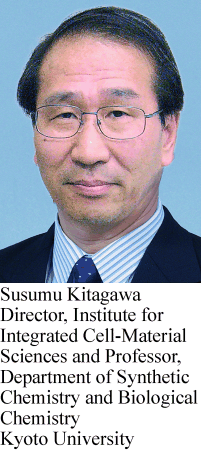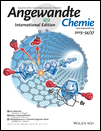Porous Materials and the Age of Gas
Graphical Abstract
“…︁ Materials that achieve mass storage and highly efficient separation of gases cannot be realized by simply improving conventional technology. The achievements in the field of metal–organic frameworks have rapidly and significantly advanced materials research that is vital to addressing energy and environmental issues…︁” Read more in the Editorial by Susumu Kitagawa.
With the industrial revolution in the 19th century, humans began to create technologies that consume huge amounts of energy. Initially, people used solid coal as an energy resource, in the 20th century, the focus changed to liquid petroleum. In the 21st century, where the depletion of petroleum has become a critical concern, gases (e.g., natural gas and biogas, and even air) should play important roles—an “age of gas” is dawning. However, a gas is a form that is difficult to handle because it is easily dispersed, creates mixtures, has a low concentration under normal conditions, and is invisible. The conventional transportation, storage, and conversion of gases consume massive amounts of energy and require harsh conditions (e.g., high pressure and extremely low temperature). Scientists and engineers have to cooperate to find ways that allow gases to be handled under mild conditions (i.e., ambient temperature, low pressure, and low energy consumption). As porous materials have great potential for practical applications in diverse fields, they are scientifically interesting and industrially extremely valuable.
At the end of the 19th century there was concern that when the world population reached one billion, people would suffer from food shortages. Additionally, it was believed that the global population could not exceed four billion. However, the current world population is over seven billion, as the innovations of Haber and Bosch realized the epoch-making industrial manufacture of nitrogen fertilizer from atmospheric nitrogen and allowed the subsequent dramatic enhancement in food production. This great accomplishment shows that society could benefit from innovation that allows the creation of useful materials from ubiquitous gases.
Both gases (especially air) and water (in the form of rain, fresh, and salt water) are ubiquitous, and are contain the fundamental elements necessary for fuel and chemical products. Given the world population has been predicted to reach 12 billion in 2100, we must use science and technology to allow future generations to continue to live with a sense of security.

In this context, porous materials with nanosized voids will contribute significantly to the science and technology of gas handling. Porous materials have been around for centuries; one of the earliest examples is activated carbon, which was used as a medicine in ancient Egypt. In 1756, zeolites were discovered in natural ores, but were not prepared synthetically until the early 20th century. Today, zeolites have many applications (e.g., in the petroleum industry). The discovery of porous materials with features superior to conventional materials should revolutionize our society. The introduction of porosity, even on the nanoscale, is quite difficult as (to quote Aristotle) “natura abhorret a vacuo” (nature abhors a vacuum). However, in the late 1990s, there was a breakthrough when novel porous materials, called porous coordination polymers (PCPs) or metal–organic frameworks (MOFs), were first realized. For the sake of consistency, I will refer to these materials as MOFs. In recent years, porous materials have been used in diverse applications and have become indispensable.
Consider a chemical separation process as an potential application of porous materials. Presently about 40 % of the total energy consumed in the entire chemical industry is used for separation and purification processes, such as distillation. Furthermore, about 15 % of the energy produced worldwide today is used to separate and purify industrial commodities (e.g., gases and water), and the demand for these commodities is expected to triple by 2050. To meet today’s demand for energy saving and safety, materials that achieve mass storage and highly efficient separation of gases cannot be realized by simply improving conventional technology. MOFs have three important features, namely 1) they can be designed to particular specifications, that is, coordination sites for the gas molecules to be adsorbed can be designed rationally; 2) they have an extremely high porosity, which is enabled by the structure comprising metal ions and organic molecules; 3) they have a regular structure and no “wasted space”. Therefore the pore functions in MOFs can be tailored to specific needs, and MOFs can be developed to selectively bind or separate target gases by introducing functional groups into the pore walls so that guest-specific interactions occur. In fact, an excellent binding/separation performance has been achieved by introducing functional groups into the pores. For example, amino groups or hydrogen-bonding donor groups as bonding sites have been introduced for carbon dioxide or acetylene, respectively. The ability to be designed specifically is only one of the many excellent features of MOFs. Three noteworthy properties (flexibility and softness, collective behavior of the voids, and diversity in spatial and electronic structures) will now be emphasized here as they should become increasingly more important as these materials are developed.
Heraclitus, an ancient Greek philosopher, had the insight that “no one ever steps in the same river twice, for it’s not the same river and he’s not the same man.” Thus, in the context of MOFs, his words can be interpreted as “structures” changing from static and rigid to dynamic, flexible, or soft (spatiotemporal structures). Studies on porous materials have conventionally targeted rigid structures with regular porosities, such as zeolites. Here, let’s flip the perspective and consider substances with “changeable” porosities. MOFs are composed of organic molecules (ligands) and metal ions. The flexibility and softness of these materials arise when the movements (e.g., twisting, rotation, and extension) of the ligands and the metal–ligand bonds extend across the entire framework. With these movements, the micropores can change their shapes by shrinking and expanding, which allows them to respond to external stimuli (e.g., guest molecules, heat, light, pressure, and electrical and magnetic fields). The second important property of MOFs is the collective behavior of the voids. The pores and channels in MOFs are interconnected, and spread over the entire solid so that the pores are considered as one collective structure. Therefore a change in one part of the structure is immediately transmitted to the next one, thus causing the change to spread throughout the entire system. This cooperative behavior is quite important for the unique characteristics of MOFs. Although cage-type molecules and capsule-type molecules both have porous structures, they differ significantly from MOFs because their pores are separated from each other and are not interconnected. As examples of a non-interconnected and an interconnected porous structure, consider myoglobin (Mb) and hemoglobin (Hb), which are both oxygen carriers in the human body. Mb, a monomer protein, displays normal oxygen-adsorbing behavior, whereas Hb, a tetramer protein, shows cooperative oxygen adsorption based on the interactions among the four protein molecules and provides a sigmoidal adsorption curve. Such a cooperative effect as has been difficult to achieve with conventional inorganic and carbon-based materials. In other words, MOFs simultaneously exhibit the regularity of inorganic materials and the flexibility of organic polymeric materials. The third property of MOFs is their diverse (electronic) structures that arise from the different combinations of the charge and spin states of the metal ions, and the electronic structure of the organic ligands. Specifically, differences exist not only in the interactions between the framework and guest molecules, but also in the electronic state of the framework itself, and therefore in the electronic conductivity, dielectric properties, and charge-transfer performance.
The three properties (flexibility, collective behavior, and diversity in spatial and electronic structures) not only offer a wide range of applications (e.g., adsorption, binding, detection, separation, transportation, and conversion of gases), but also should provide functions, which were previously impossible to realize, through the cooperative effects with guest molecules. A “phase-change” MOF for example can separate CO from a mixture of CO and nitrogen, despite the fact that the two gases have similar molecular sizes and boiling points. With a similar MOF, effective separation of CO2 from flue gas has been realized. I refer to such a sorption process, which utilizes cooperative effects, as a “self-accelerating sorption process”.
By concentrating on the three key properties, flexibility, collective behavior, and diversity in spatial and electronic structures, the design of materials should shift from the conventional chemistry, which emphasizes low weights and high porosity, to a more novel one, which involves the synthesis of tailor-made porous materials for solving specific tasks.
Finally, I would like to point out the importance of controlling the integrity, size, and shape of the crystals when creating new functions and phenomena. As a perfect crystal cannot be realized, MOFs contain defects, which may lead to issues with the diffusion of guest molecules. However, defective sites often provide desired effects because of their chemical activities, and the control of these sites can be very important when MOFs are used as catalytic or electronically conducting materials. Hybrid materials of MOFs and nanoparticles or organic polymers are a particularly appealing field of research. Furthermore, MOFs with channels that can enable directional transport, similar to biological membranes, should also be realized. The achievements in the field of MOFs have rapidly and significantly advanced materials research that is vital to addressing energy and environmental issues.





